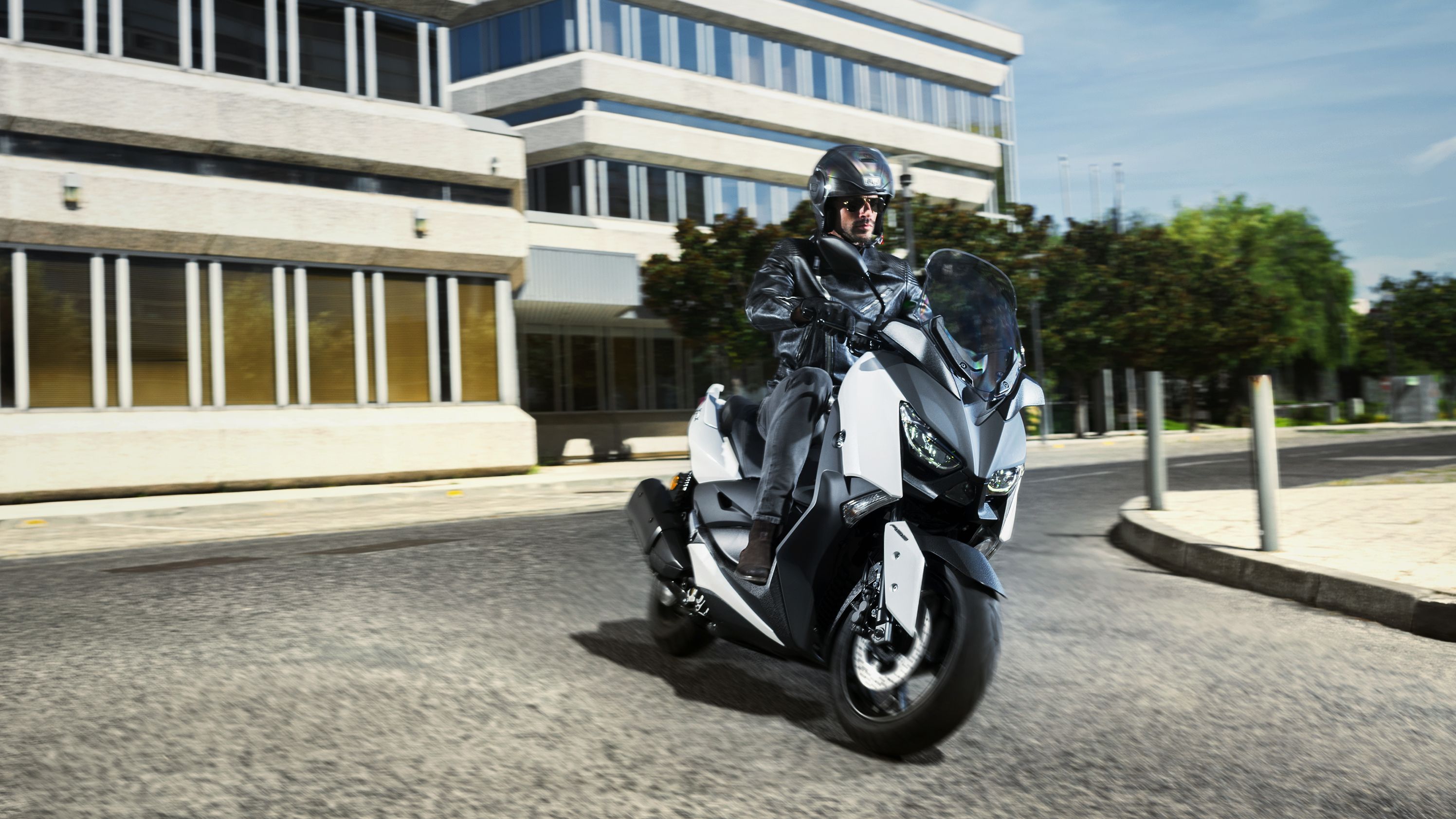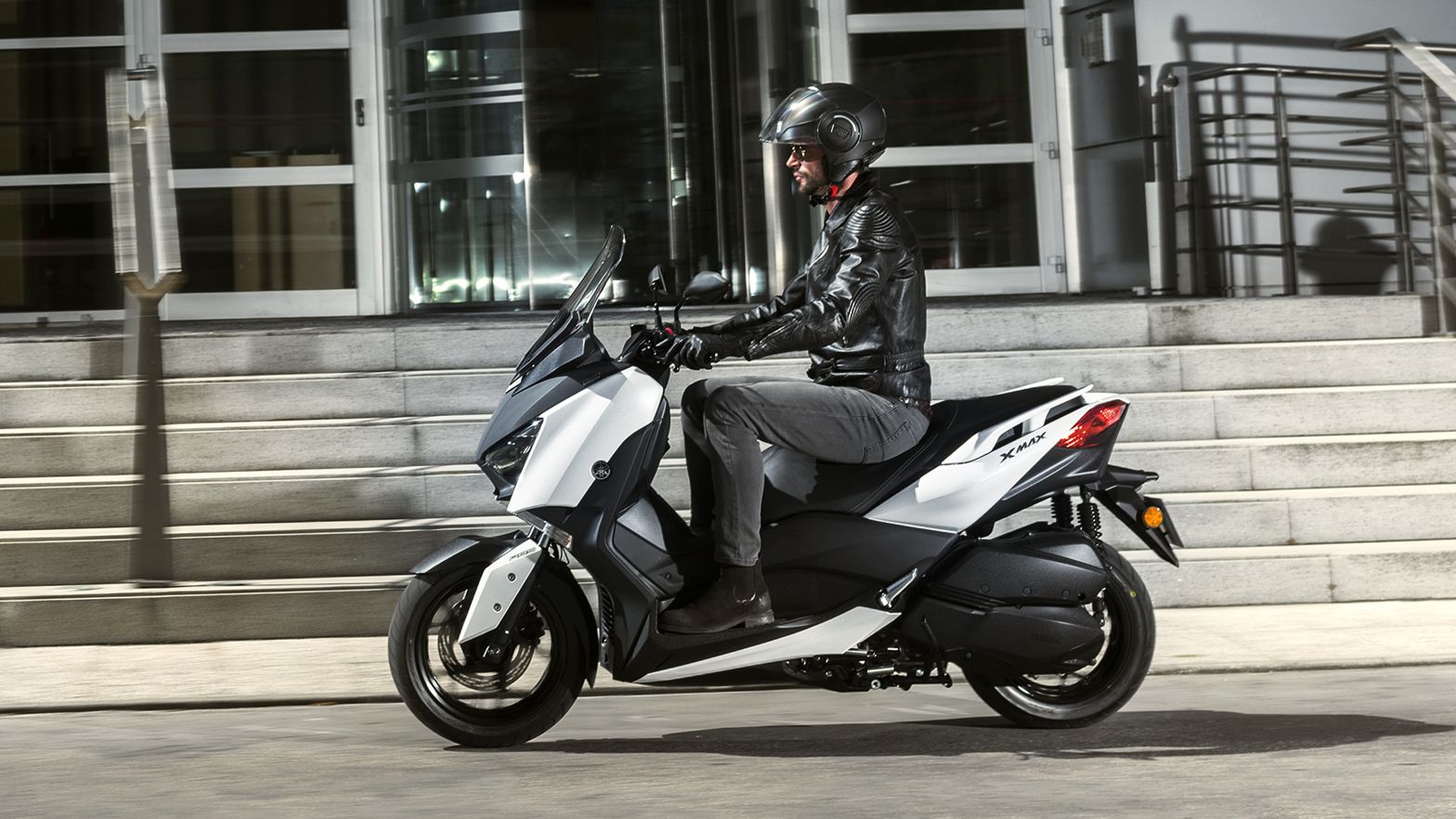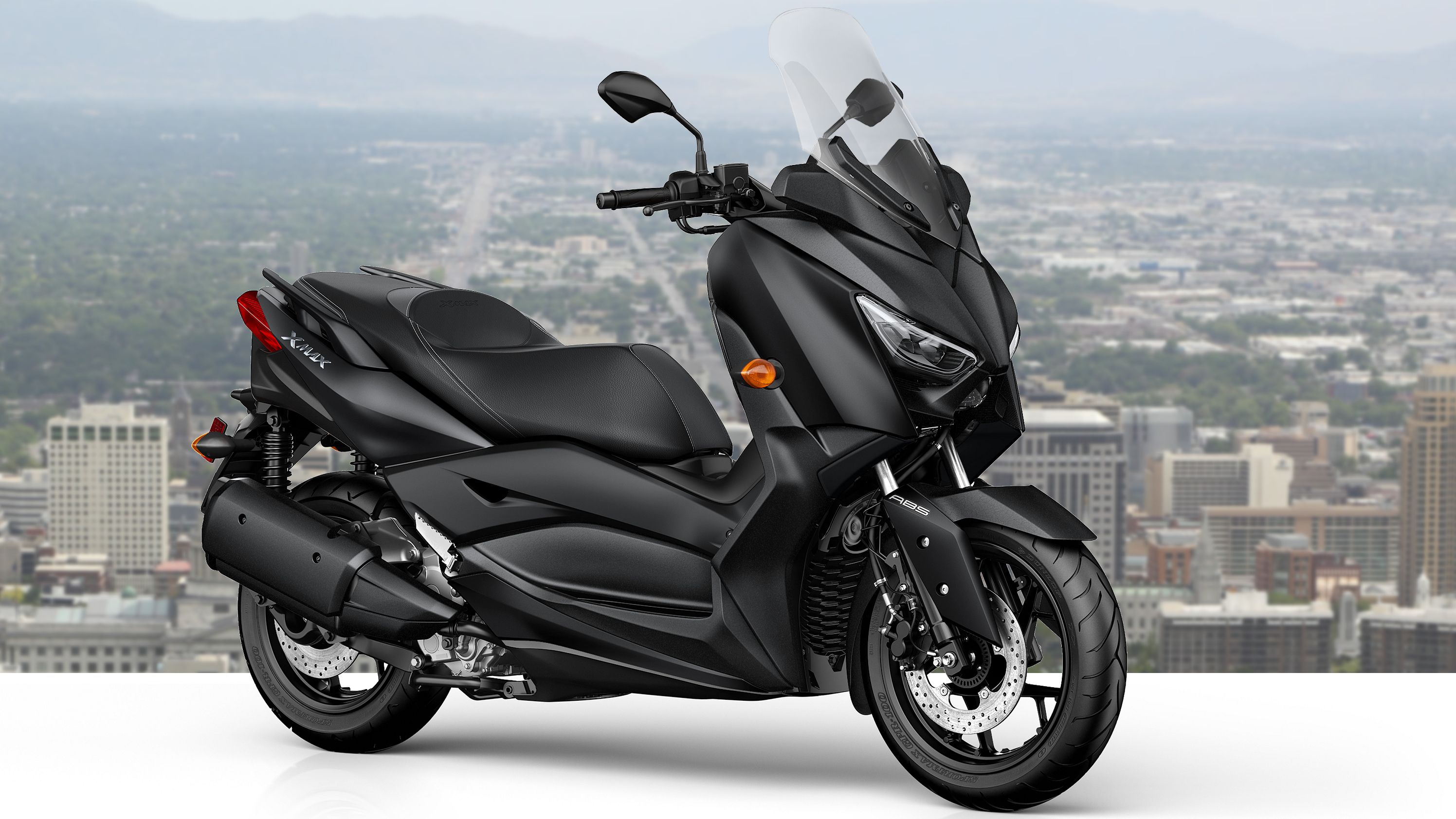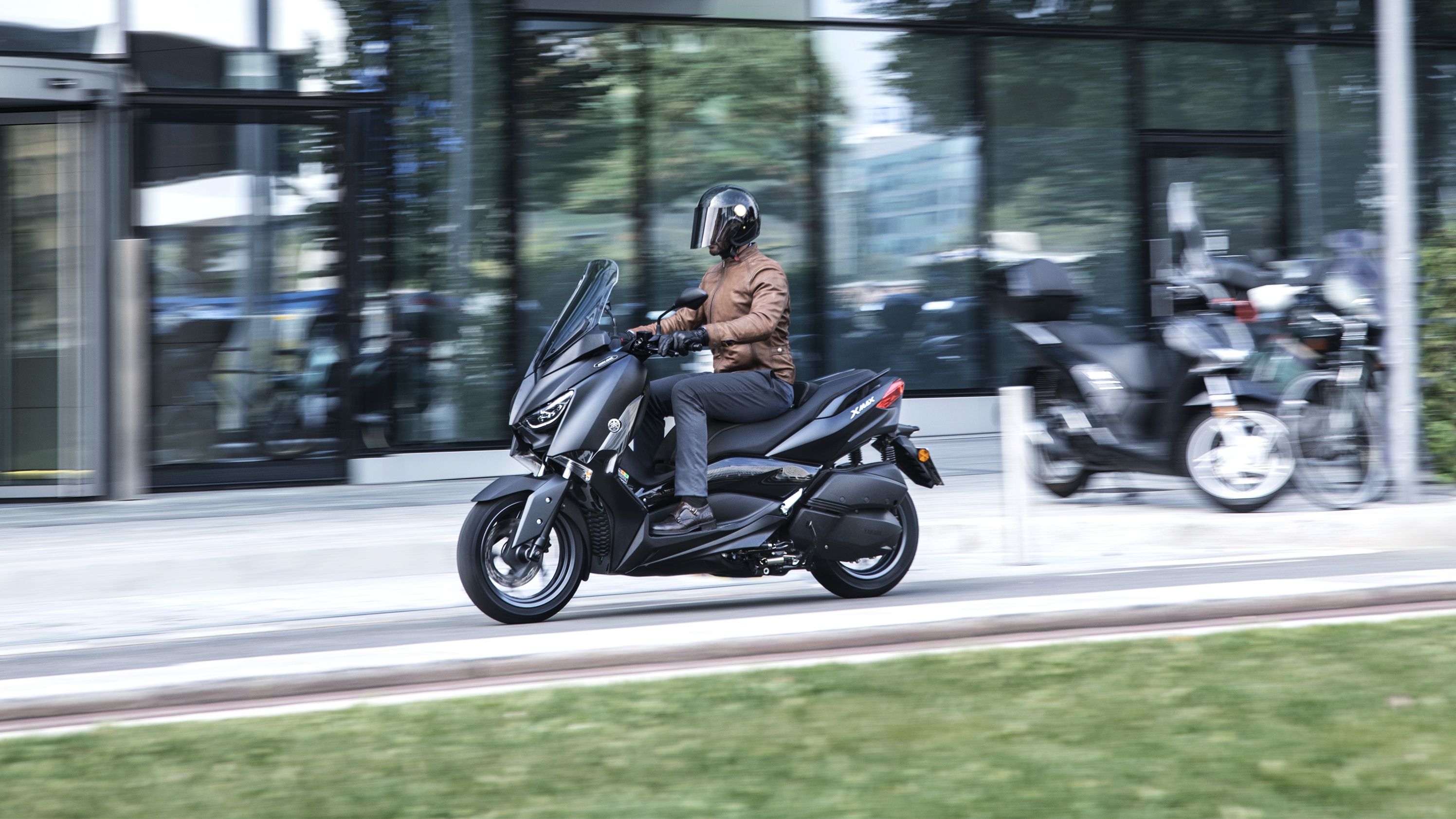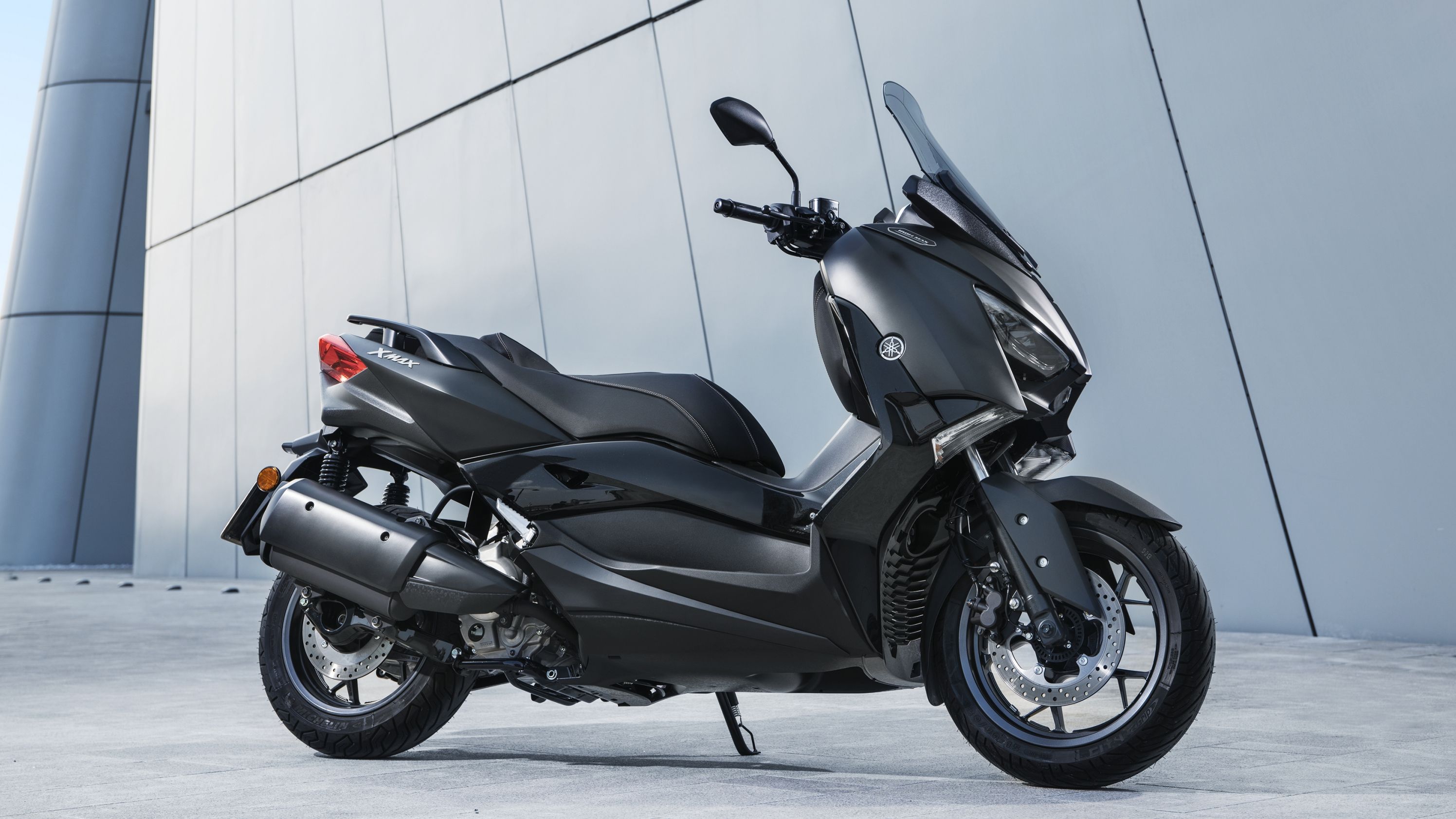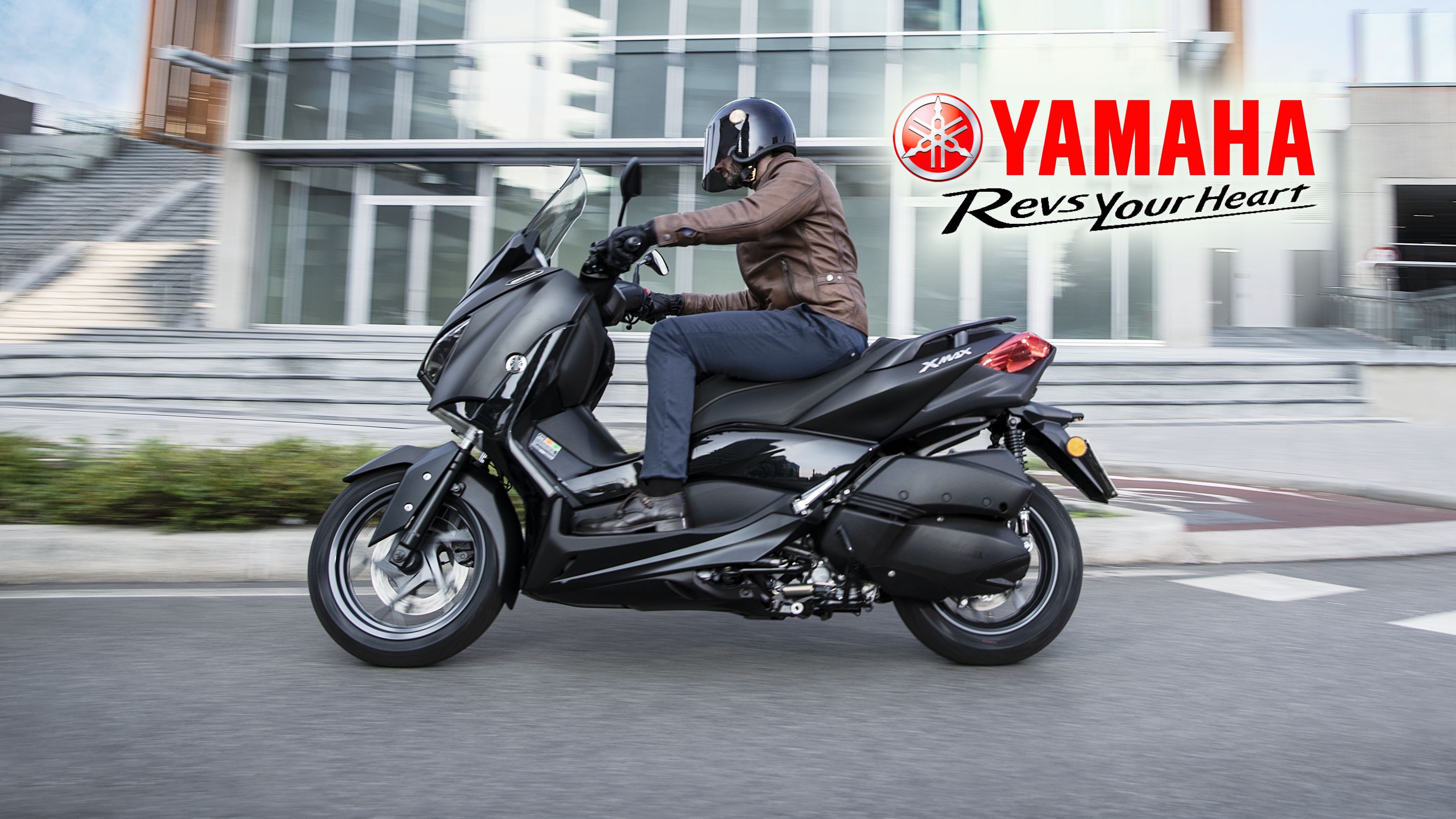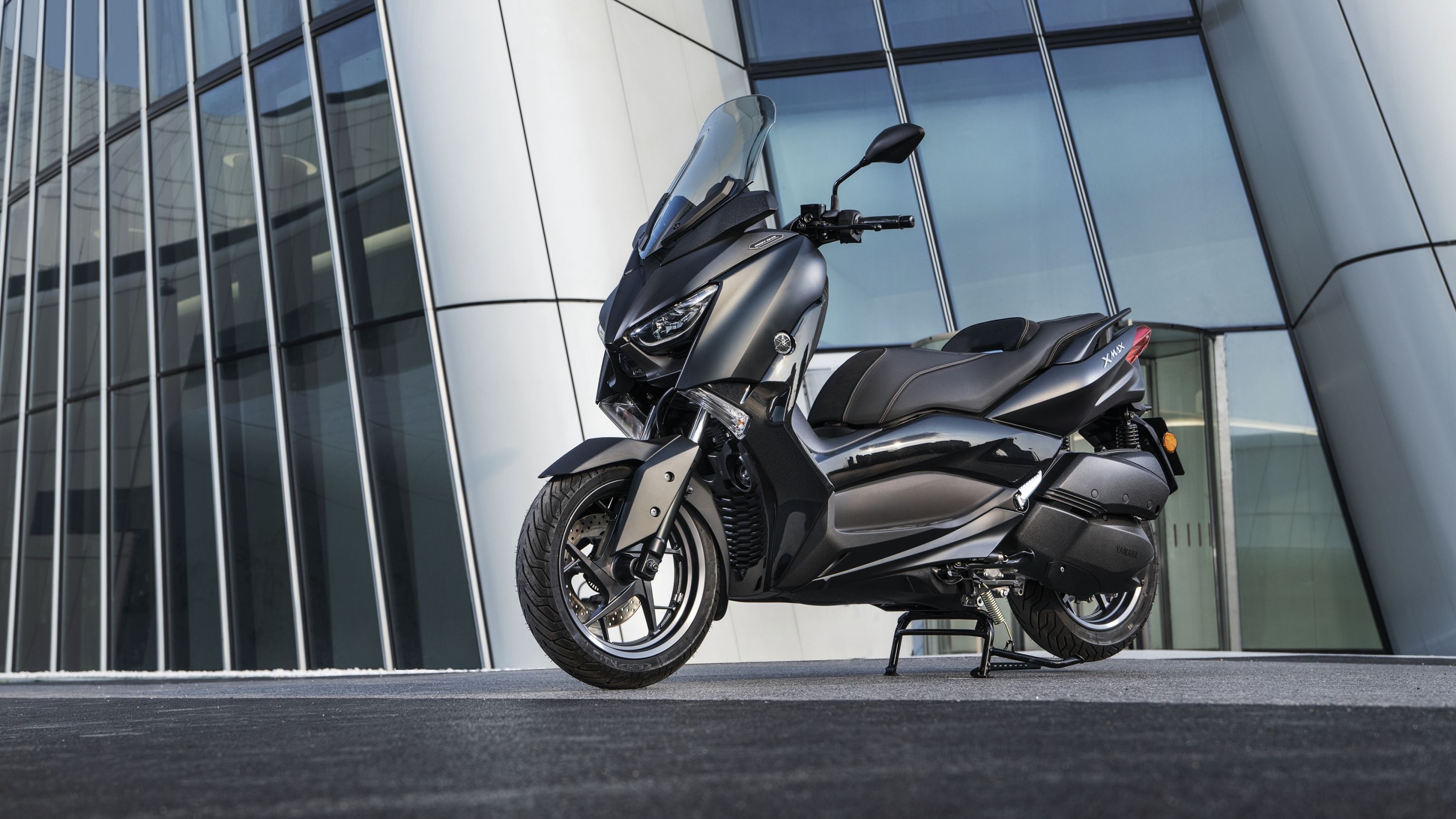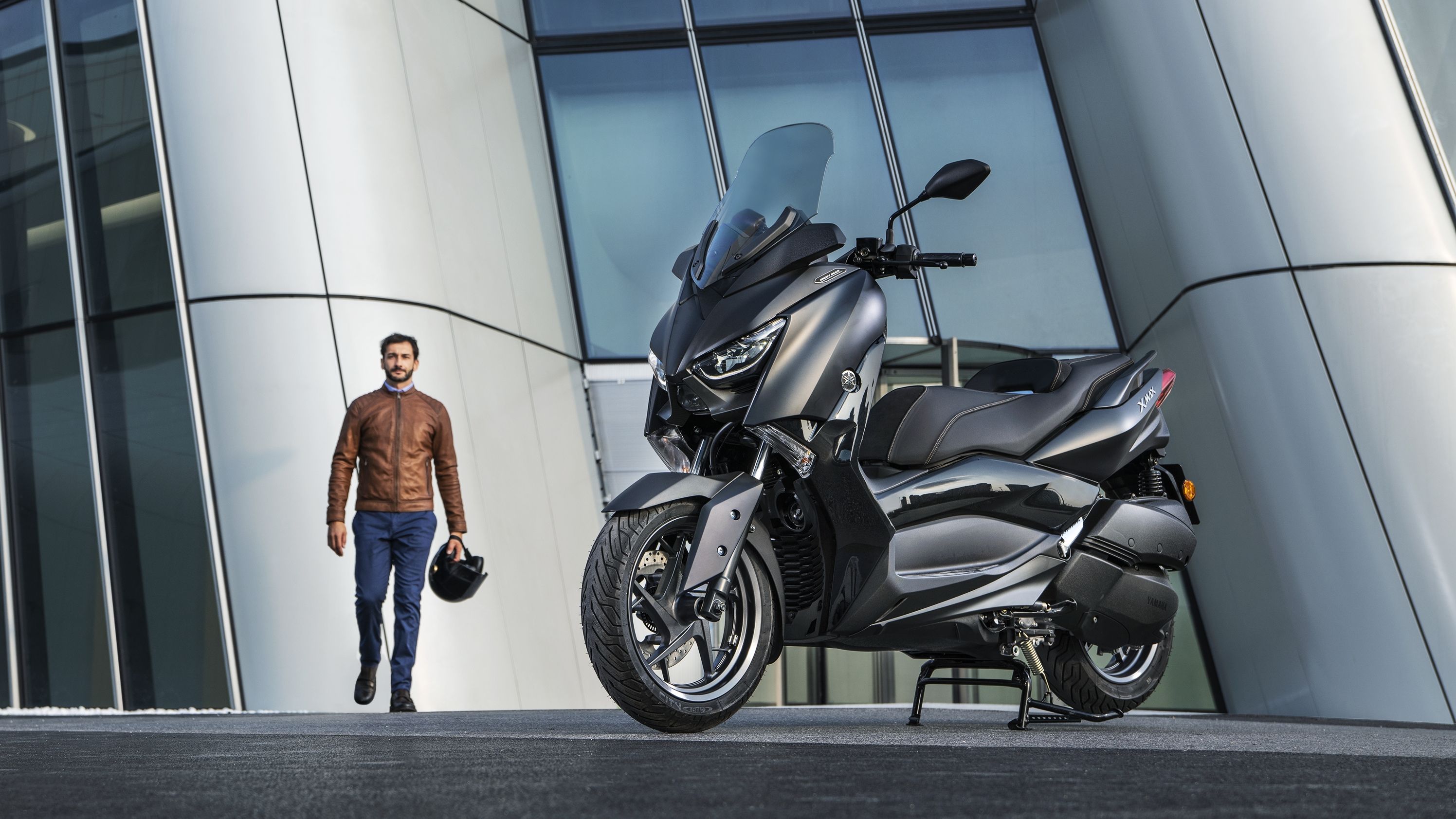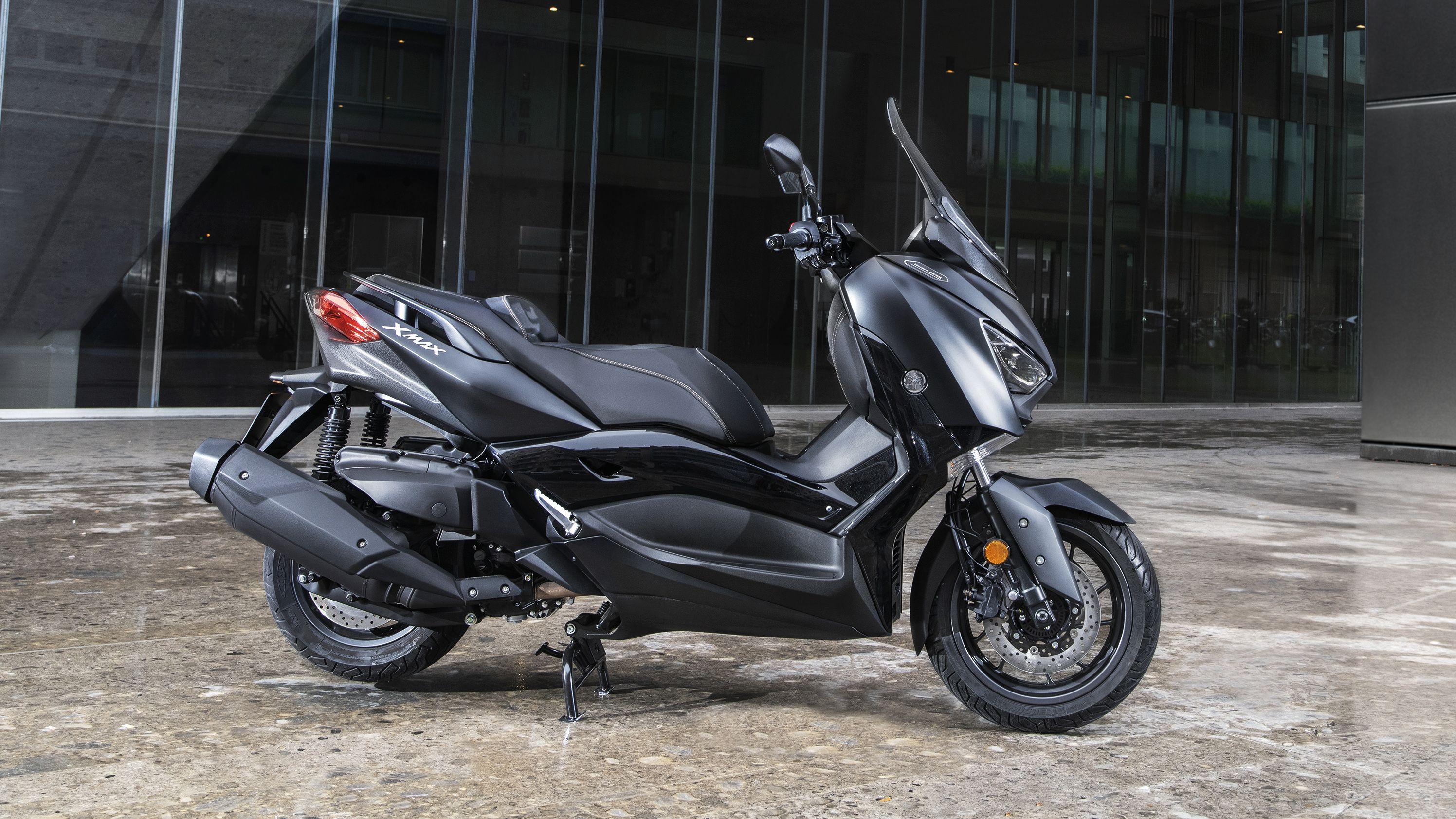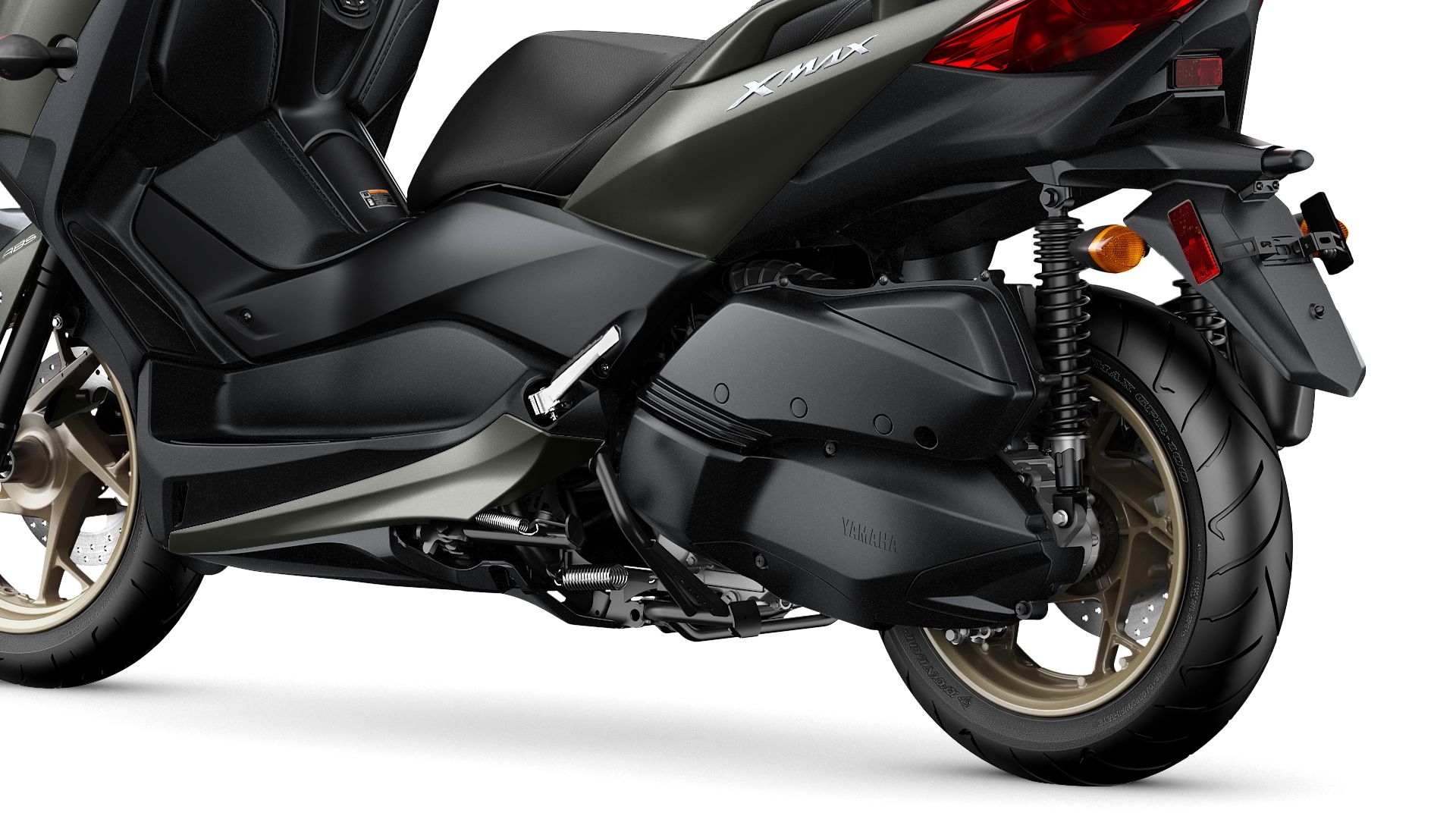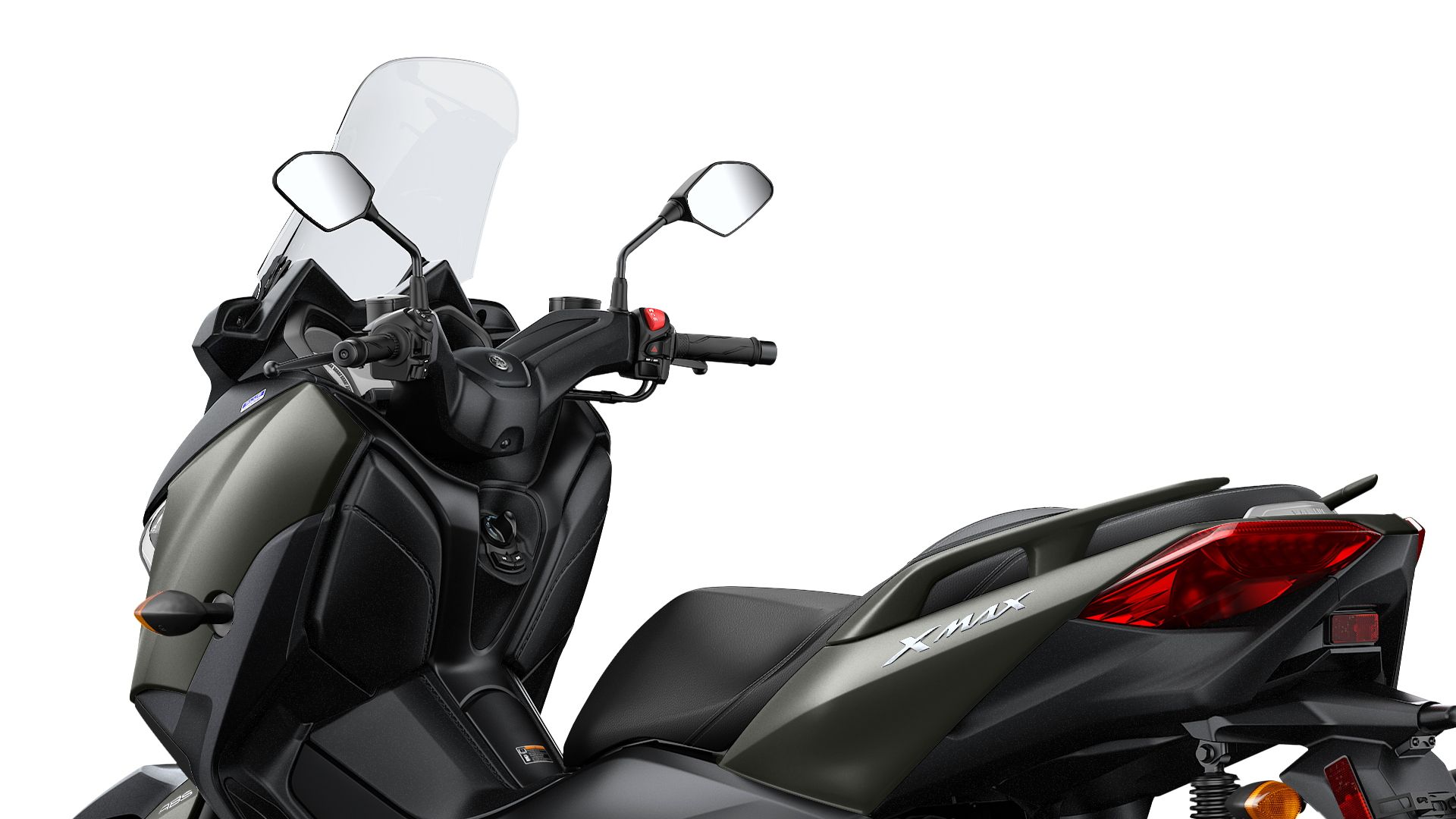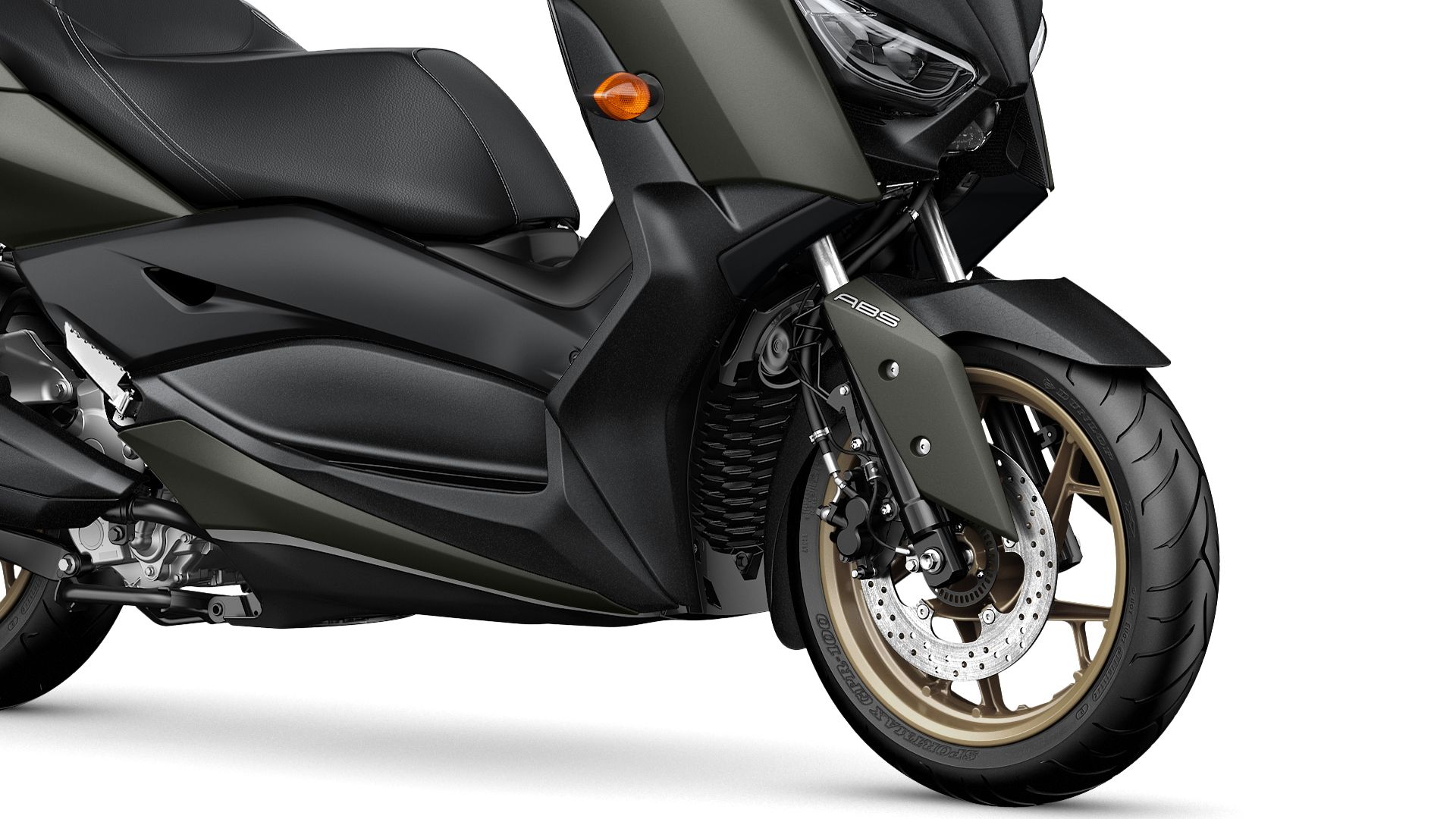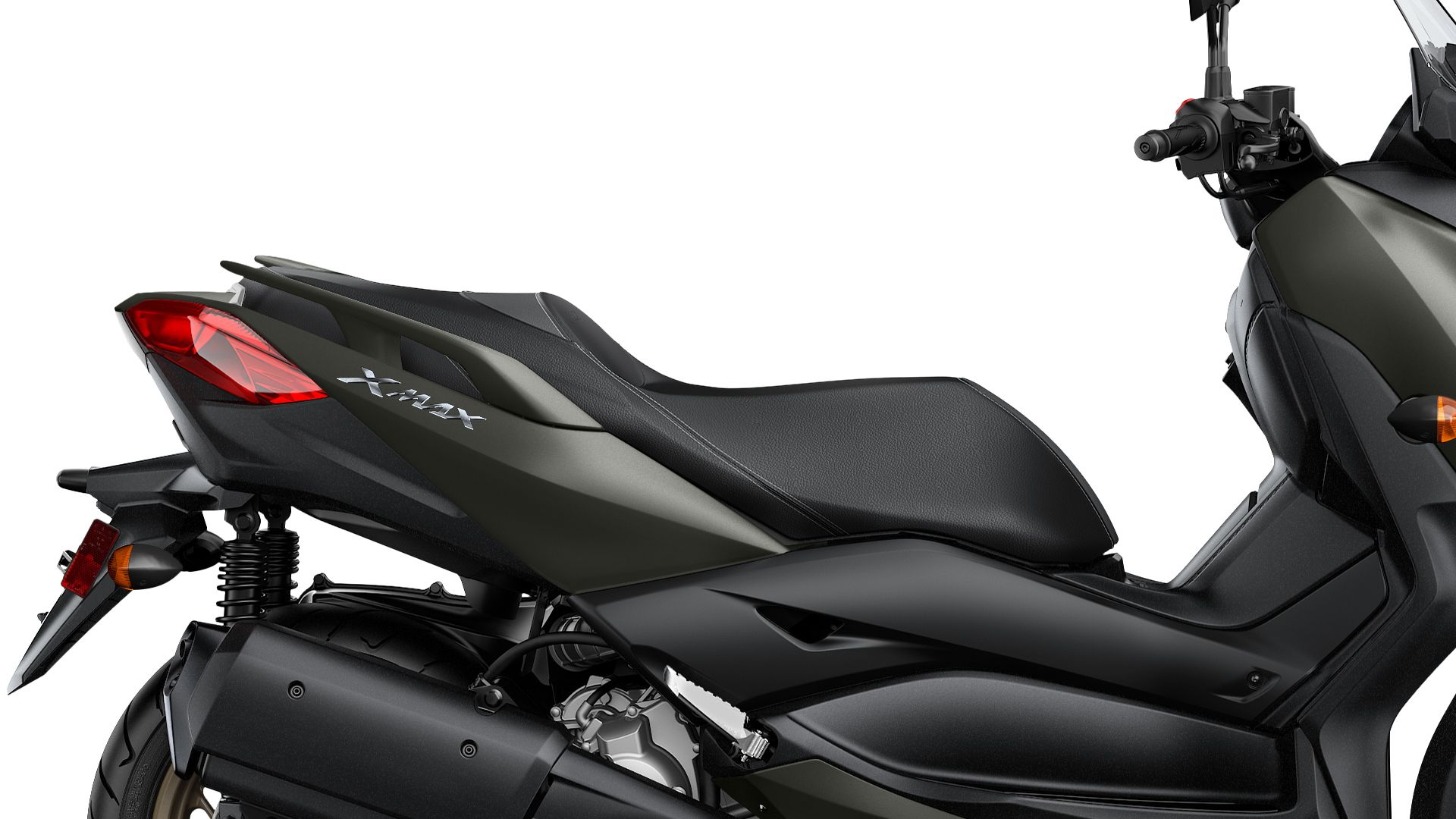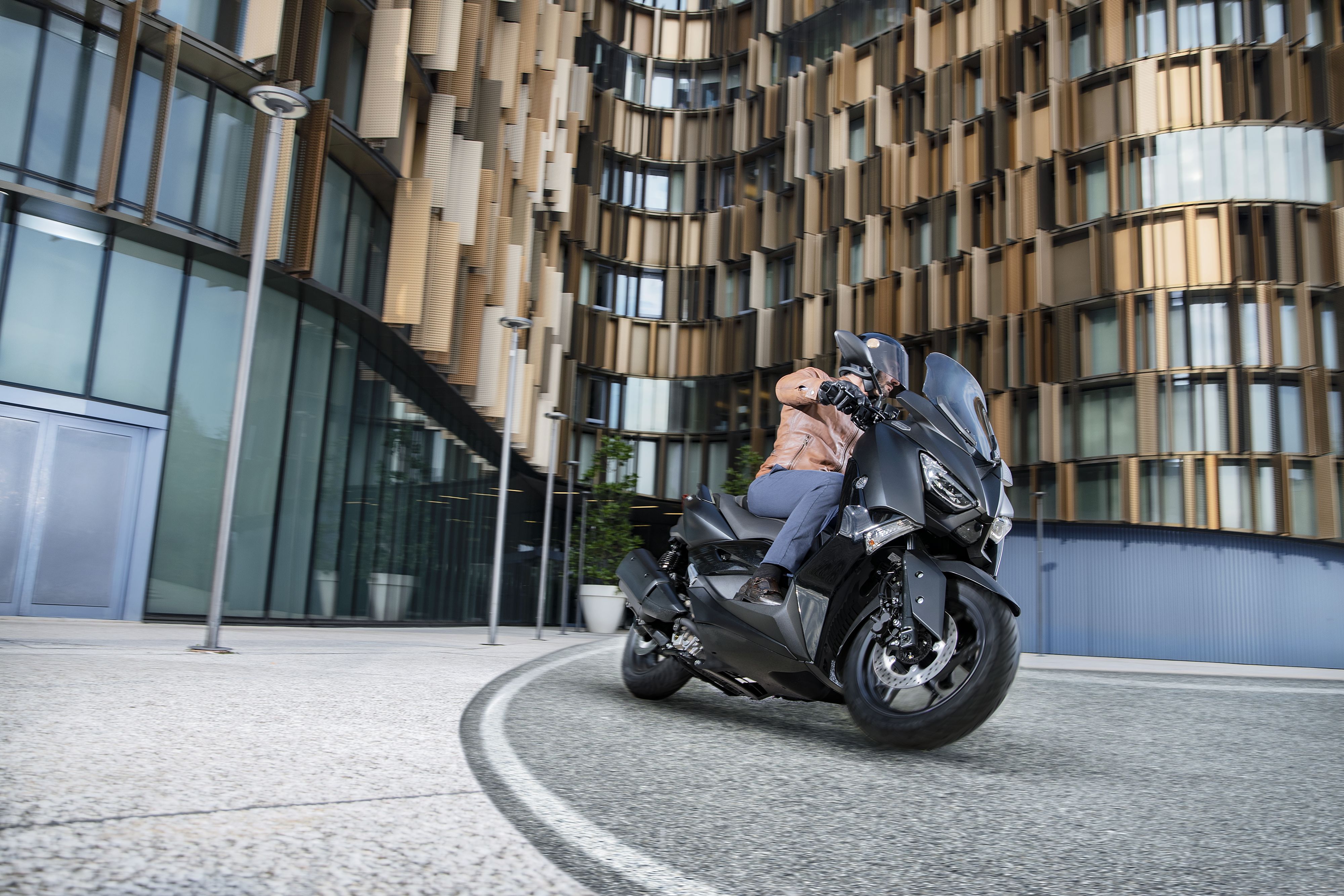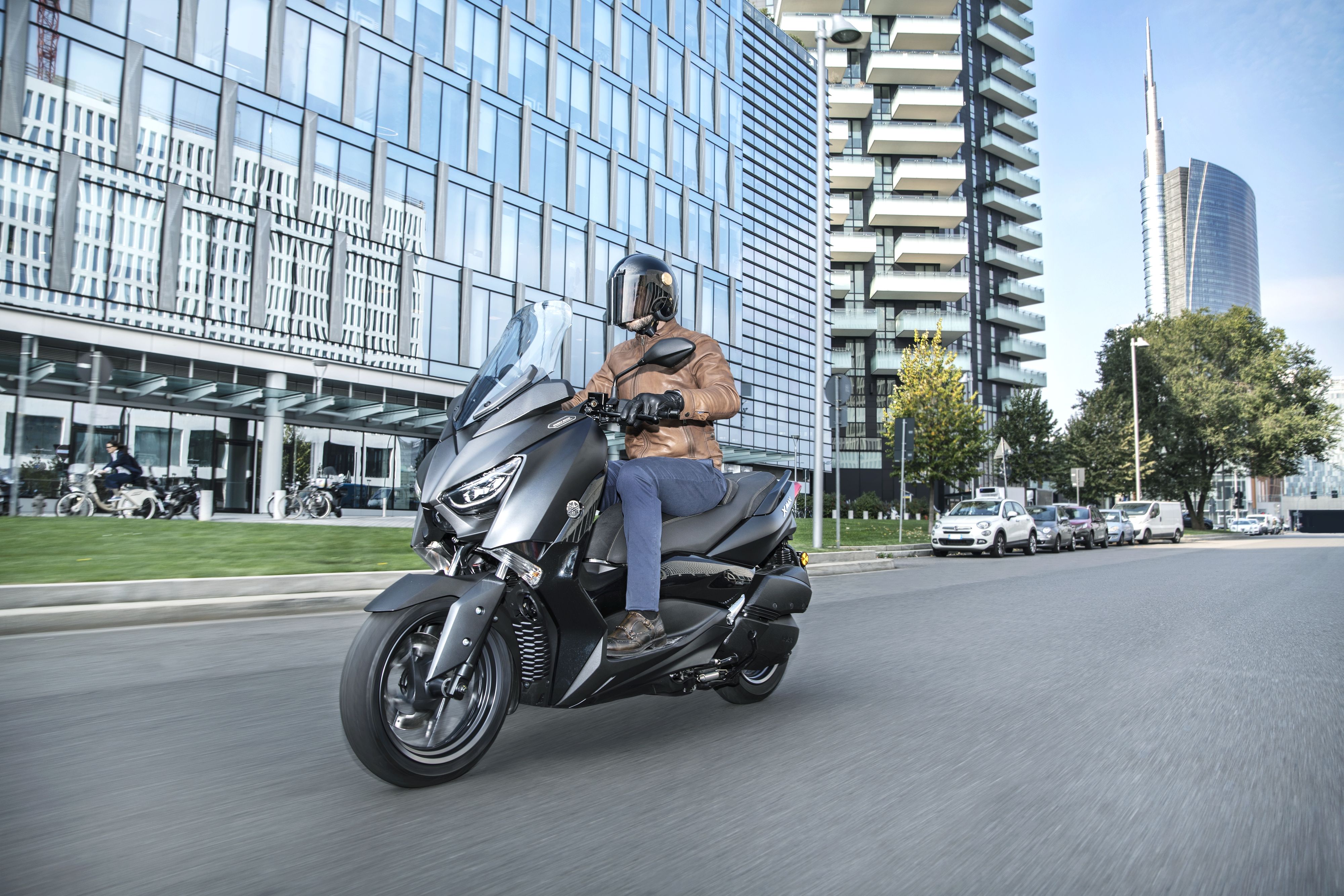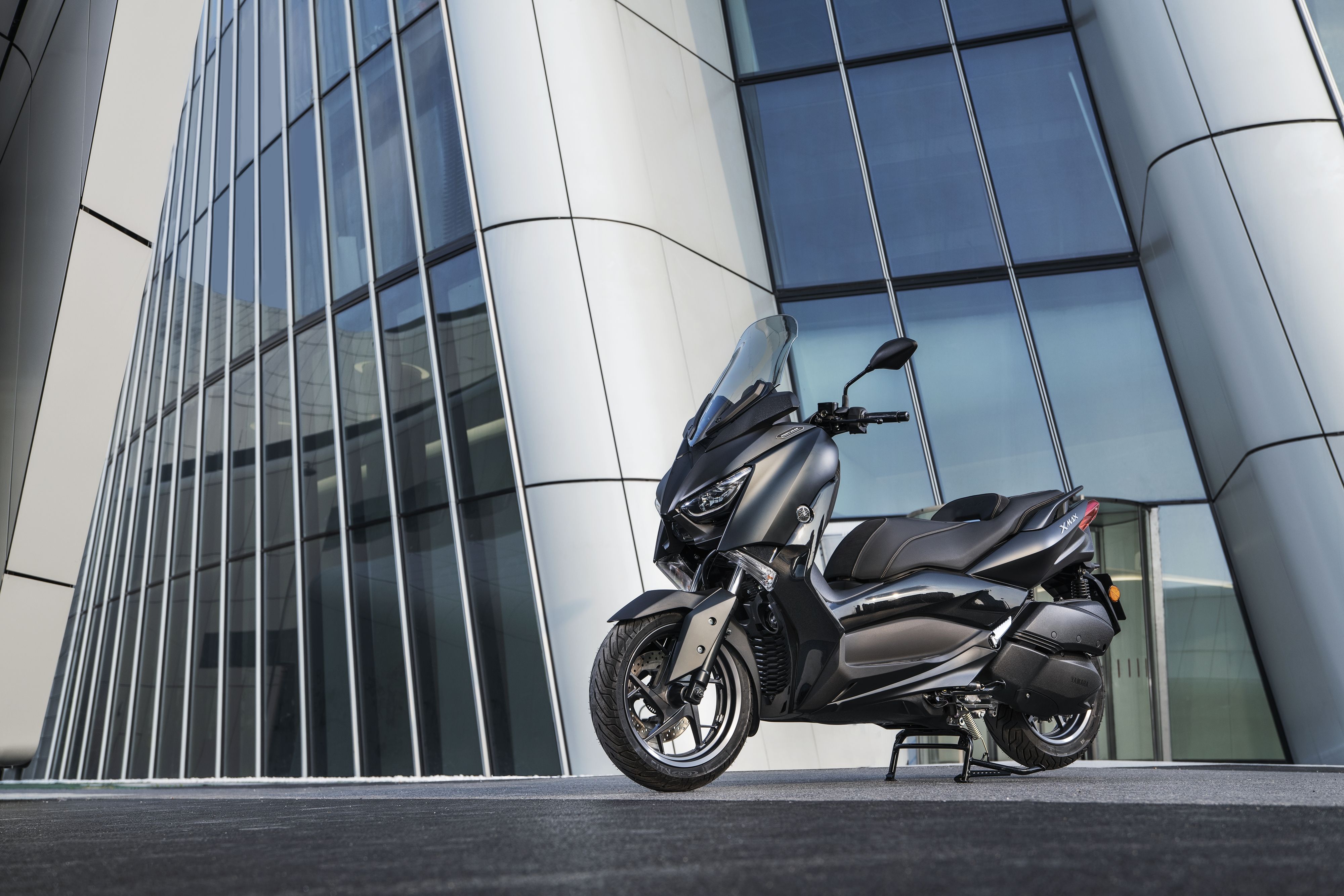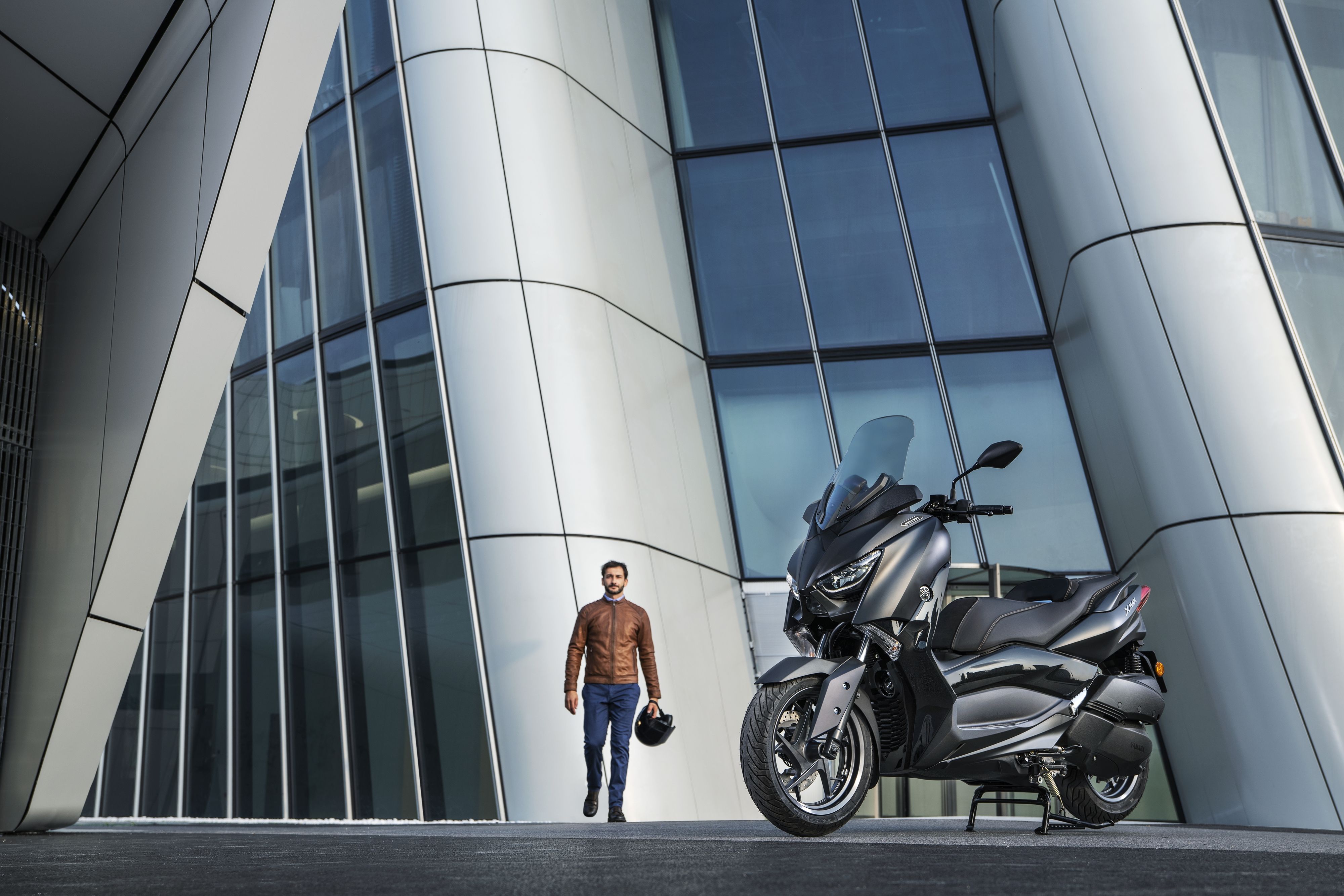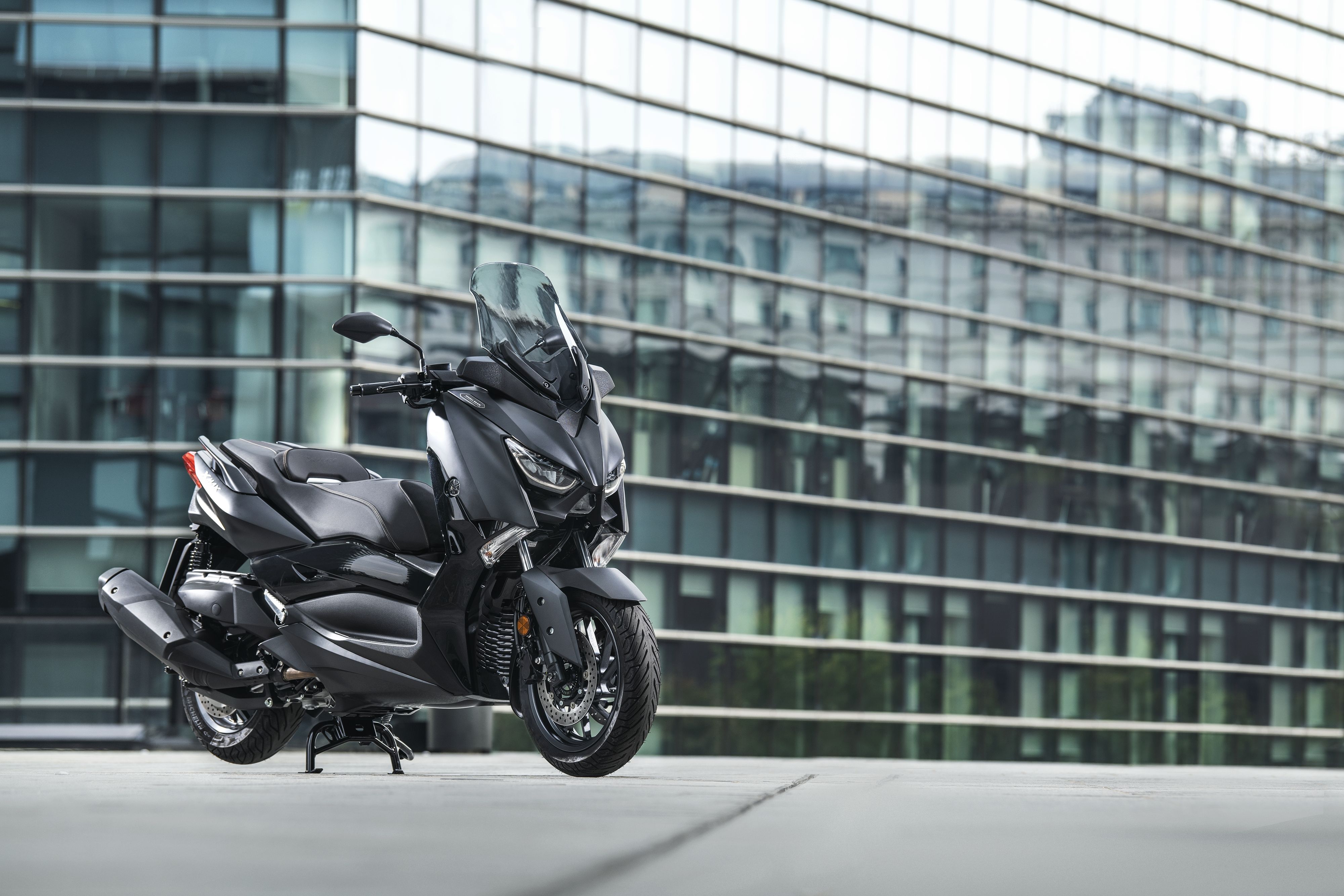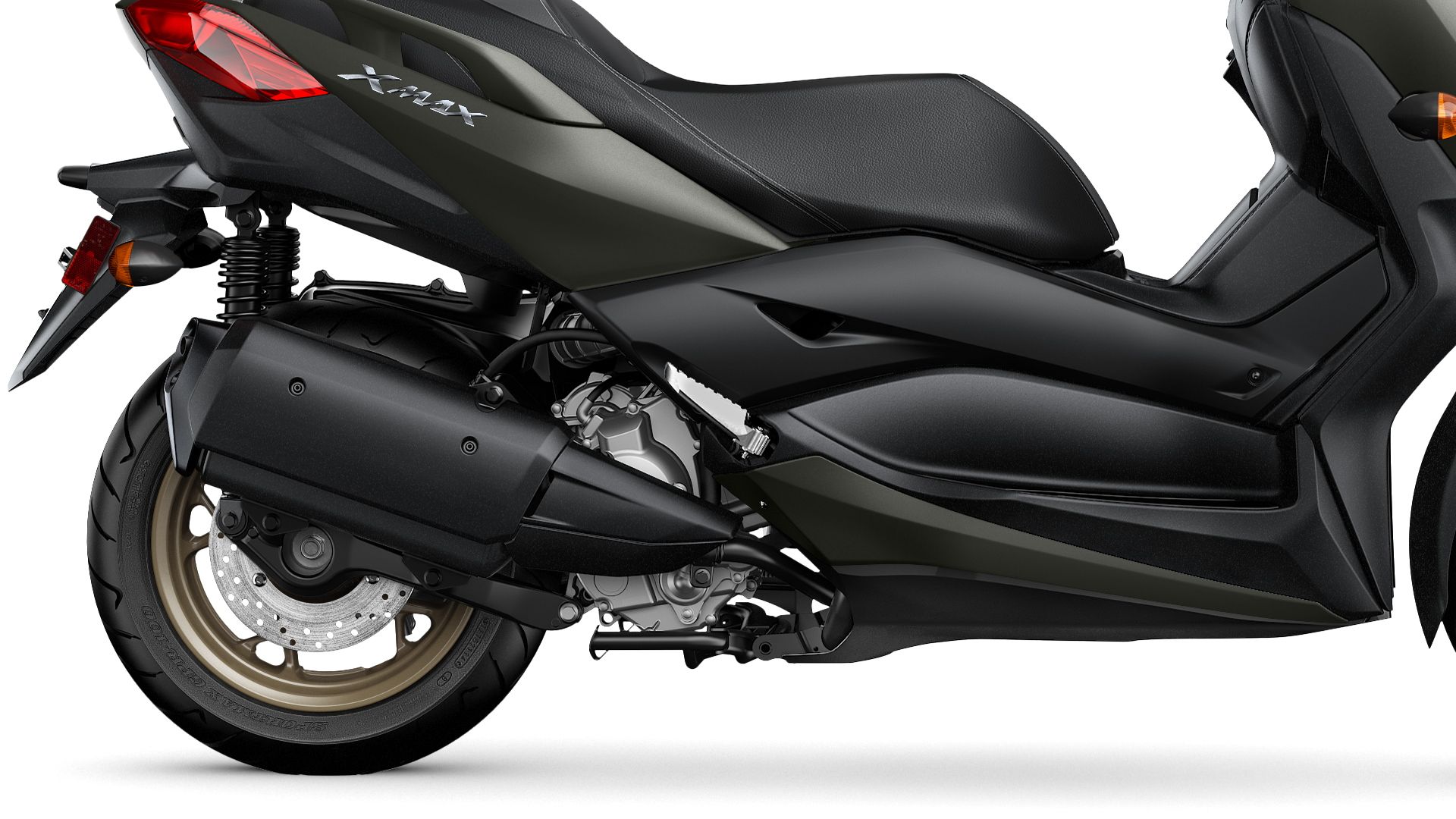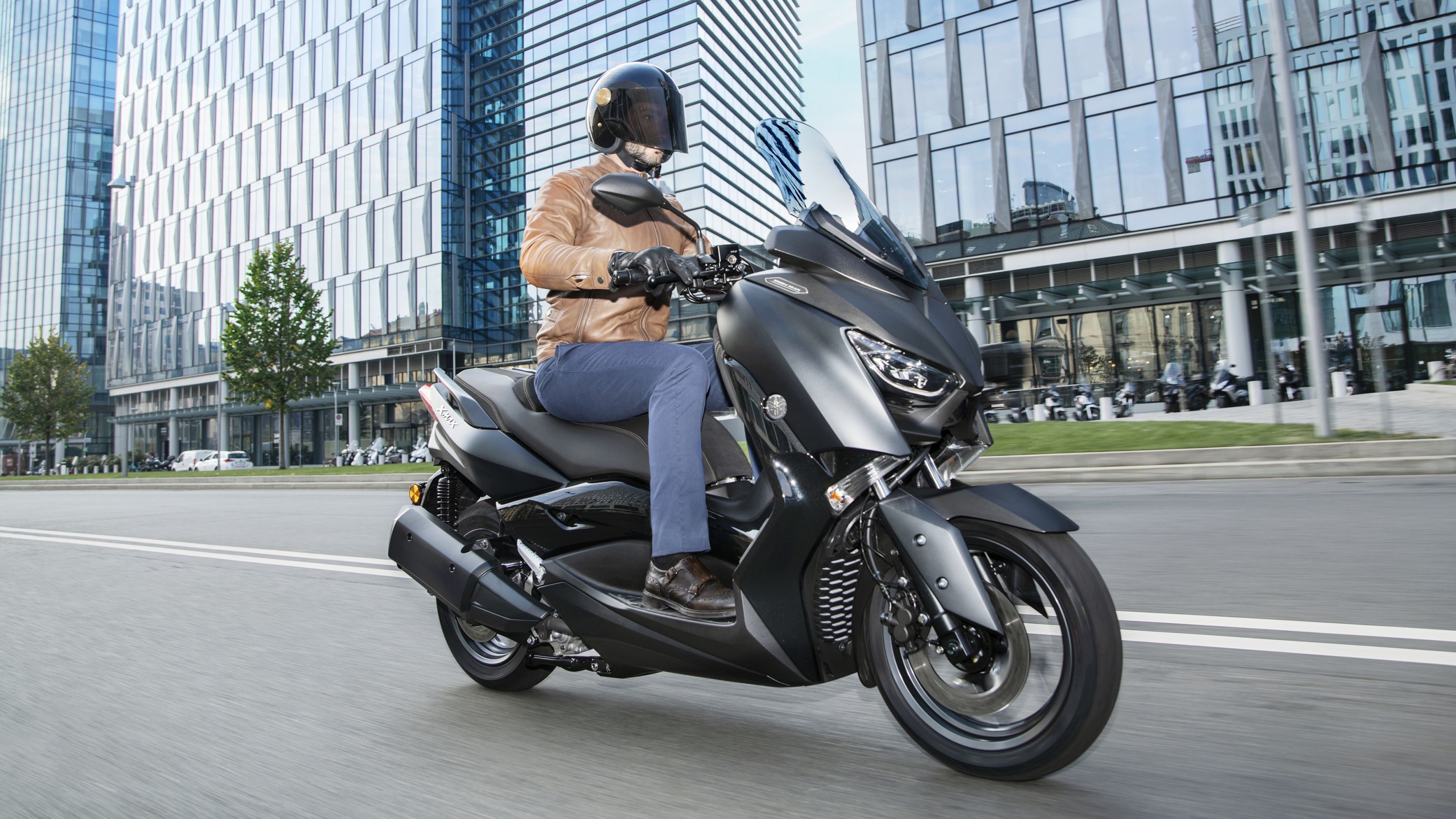Yamaha brought the XMAX to the U.S. market with a 27.6-horsepower mill that promises enough speed to be safe, even comfortable, at highway velocities, and that's muy importante in the American market. This performance comes bundled with a decidedly modern and mature look that just screams metro-commuter.
2018 - 2022 Yamaha XMAX
- Make: Yamaha
- Model: 2018 - 2022 Yamaha XMAX
- Engine/Motor: single cylinder
- [do not use] Vehicle Model: x-max
Yamaha XMAX Design
Our European friends have had a few years to test it, but we don't use scooters quite the same way here and don't even get me started on their tiered-licensing system. Salient point is, I'm going to put some homegrown eyes on this thing to see how it will hold up to scrutiny from a local point of view.
Right off the bat, I gotta say I'm lovin' the whole angry-centurion visage that greets the eye from the head-on perspective. The slanted headlights and cheekplate fairing complete with nosepiece sells the look while serving as the first layer of protection for the rider. Up top, a rather full windshield protects the torso, and the two-position, screen-height adjuster allows you to crank it up another two inches for an even bigger pocket of protection.
Below the lights, the fairing shape flows into the full legguards that extend the pocket all the way down to the feet. Although a rather large tunnel dominates the step-through area and pushes the feet outboard, it does leave room to keep your legs tucked into the pocket whether you use the floorboard position or the forward “highway peg” position molded into the inner fairing.
A sculpted seat comes cut so as not to interfere with the thighs while standing with training wheels (feet) deployed which should make it more accessible to shorter riders in spite of its 31.3-inch seat height. Yamaha added adjustable handlebars that can be pulled almost three-quarters of an inch closer to the rider to further accommodate the vertically-challenged.
Under the seat, a voluminous, lockable storage compartment can store up to two full-face helmets with LED lighting to help out when fumbling in the dark. Storage isn't limited to the seat box though, the inner fairing sports a pair of compartments for small items and one of them is wired for 12V DC with an electronic lock for the safe storage/charging of your mobile devices. The rear end is as modern as the front with molded-in taillights and a plateholder/mudguard to contain the spray off the rear tire.
While there are grab rails built in, the low-profile pillion pad seems to be more appropriate as a flat spot for storage than a passenger-friendly place to sit. Plus the grab rails make a great place to anchor your bungee net. The level of rider protection and storage capacity coupled with the highway-conquering power is what makes me think it could be appropriate as a white-collar commuter.
Yamaha XMAX Chassis
Yamaha handled the underpinnings on the XMAX less like it was building a scooter and more like it was building a motorcycle with a proper tubular-steel frame rather than a monocoque assembly for the main structure. The 15-inch front wheel and 14-inch rear are comparable to many current small to mid-size cruisers and streetbikes, and even though it falls short of the current 16-inch max for production scooters, the hoops are plenty big enough to improve handling far beyond what you would get from the classic rinkey-dink donut tires.
At the tripletree, we find another motorcycle-like feature. Unlike many scooters nowadays, the XMAX runs with both an upper and a lower clamp that strengthens the front end and stiffens the forks against torsional forces. a lower clamp that strengthens the front end and stiffens the forks against torsional forces.}} As you might expect, the suspension is pretty plain with no adjustments on the 33 mm front stems, and only the obligatory spring preload on the dual coil-over rear shocks.
The factory kept overall weight down at a low 397-pounds wet, but didn't skimp on the brakes. Hydraulic calipers with a 267 mm front disc and 245 mm rear give the XMAX its stopping power, and the stock ABS ensures that you can use the brakes to their fullest without fear of the lockup that immediately precedes the tears.
Suspension, Front/Travel: | 33 mm telescopic fork/ 4.3 in |
Suspension, Rear/Travel: | Dual shocks/ 3.1 in |
Brakes / Front: | Hydraulic disc, 267 mm; ABS |
Brakes / Rear: | Hydraulic disc, 245 mm; ABS |
Tires / Front: | 120/70-15 Dunlop® Scoot Smart |
Tires / Rear: | 140/70-14 Dunlop® Scoot Smart |
Yamaha XMAX Drivetrain
As big-bike-like as some of the XMAX can be, it's a straight-up scooter in the drivetrain. The all-new one-lung powerplant and continuously-variable transmission form a stressed unit that replaces the swingarm for an all-in-one assembly. A SOHC actuates the four-valve head, and liquid-cooling deals with the waste heat while attenuating some of the engine noise with a water jacket. The 70.2 mm bore and 75.9 mm stroke gives the mill an undersquare layout with a 10.9-to-1 compression ratio and an oil-jet feature that draws heat directly off the piston. A DiASil aluminum cylinder runs sans liner to save weight and increase heat dissipation with a forged crankshaft and counter-balancer to finish it off.
Electronic fuel injection manages the induction with a 12-hole injector tip meant to improve fuel atomization and throttle response, but the real shining star of the drivetrain is the traction-control feature that prevents loss of traction by intervening when a speed differential is detected between the front and rear tires. Seriously folks, this isn't the kind of feature you expect to find on a scooter, or any ride below eight or 10 grand for that matter, and is nothing to scoff at. Between ABS and traction control, even novice riders should be able to keep this one dirty-side down.
What does all that get us? Well, the power tops out at 7,500 rpm with a claimed 27.6 ponies with 21 pounds o' grunt that comes on at 5,750 rpm, and depending on load, grade, and tailwinds, you can expect top speed between 80 and 85 mph. So, do you see what I mean about commuter ability? We've got rider protection, safety features, highway-worthy speed capabilities, and gobs of storage, all in a modern urban package. The factory claims an estimated 75 mpg out of the XMAX's plant, but in actuality, that figure may be just a tad generous. It is an estimate after all.
Engine: | 292 cc liquid-cooled 4-stroke, SOHC single cylinder; 4 valves |
Bore x Stroke: | 70.2 mm x 75.9 mm |
Compression Ratio: | 10.9:1 |
Fuel Delivery: | Fuel Injection |
Ignition: | TCI: Transistor Controlled Ignition |
Transmission: | Automatic CVT |
Yamaha XMAX Pricing
Not exactly a budget ride, the XMAX nonetheless beats out anything in the motorcycle field as far as features-per-dollar with a $5,699 sticker. Remember, that gets you ABS and traction control. Not a bad deal.
Warranty: | One Year (Limited Factory Warranty) |
Color: | |
└ 2018: | Vivid White |
└ 2019: | Matte Black |
└ 2020: | Shadow Gray |
└ 2021: | Matte Midnight Blue |
└ 2022: | Storm Grey |
Price: | |
└ 2018, 2019: | $5,599 |
└ 2020, 2021: | $5,699 |
└ 2022: | $5,799 |
Yamaha XMAX Competitors
With such a classy look about the XMAX I felt I really needed a swanky urban ride for my comparison, and Suzuki stepped right into the slot with its updated-in-2018 Burgman 400 ABS.
Suzuki Burgman 400
The Burgman has a well put-together air with lines that flow with a synergy that illustrates the experience and confidence of the engineers, and I gotta admit I kind of like the beefy look the Burgman brings to the table. On the down side, I'm not wild about the minimal step-through on either ride.
As usual with the Burgman family, the 400 comes with a deep seat and generous lumbar support but just the basics in the way of passenger comfort. The underpinnings are pretty similar with non-adjustable, hydraulic front forks, and preload adjustments on the rear shocks. Disc brakes are another constant, as is the ABS protection that comes stock on both rides.
Suzuki gets a leg up in the power department. A 400 cc mill tops the XMAX by a few cubes, and it uses a DOHC setup to time the four-valve head. Suzuki offers up its Idle Speed Control feature for easy starts, but has no answer for the traction-control feature Yamaha brings to the table. Suzuki claims 30.5 horsepower and 65 mpg, but is pushing almost 100-pounds more than the XMAX so keep that in mind. Suzuki takes a beating at the checkout with a $7,999 sticker that is almost half-again more than the XMAX, and that's a lot of money for a few extra ponies.
Read our full review of the Suzuki Burgman 400.
He Said
“This is a scoot that should do well over here. It has the speed, it has the storage, and the looks don't hurt either. It was popular overseas, but this is the smallest engine that I would consider “comfortable” on the interstate, so I expect them to move well here in the States. We'll see.”
She Said
My wife and fellow motorcycle writer, Allyn Hinton, says, "The XMAX has a nice big instrument cluster with easy-to-read gauges, which I like better than a digital display. It's a very smooth ride, vibration is all but non-existent, and the seat and seating position is very comfortable. Even though the scooter looks substantial, the weight -- what there is of it -- is carried low so the handling is rather nimble and responsive. Even though the seat is wide, if you have to tip-toe at a stop, you aren't wrestling with the weight to keep it upright. There's a nice bit of tech on this with traction control and ABS, and at 75 mpg, it's an awesome commuter even if you have to pop up the interstate for a few exits. I think my only complaint, if you can call it that, would be I'd like to see bigger wheels on it. I think 16s would make this even more awesome. This is just a really nice ride for urban or suburban transportation and it's a grown-up look, so business commuting is on the table."
Yamaha XMAX Specifications
Engine & Drivetrain: | |
Engine: | Liquid-cooled 4-stroke, SOHC single cylinder, 4 valves |
Displacement: | 292 cc |
Bore x Stroke: | 70.2 mm x 75.9 mm |
Compression Ratio: | 10.9:1 |
Fuel Delivery: | Fuel Injection |
Ignition: | TCI: Transistor Controlled Ignition |
Transmission: | Automatic CVT |
Final Drive: | V-Belt |
Chassis: | |
Suspension, Front/Travel: | 33 mm telescopic fork/ 4.3 in |
Suspension, Rear/Travel: | Dual shocks/ 3.1 in |
Brakes / Front: | Hydraulic disc, 267 mm; ABS |
Brakes / Rear: | Hydraulic disc, 245 mm; ABS |
Tires / Front: | 120/70-15 Dunlop® Scoot Smart |
Tires / Rear: | 140/70-14 Dunlop® Scoot Smart |
Dimensions & Capacities: | |
L x W x H: | 86.0 in x 30.5 in x 55.7 in – 57.7 in |
Seat Height: | 31.3 in |
Wheelbase: | 60.6 in |
Rake (Caster Angle): | 26.5° |
Trail: | 3.7 in |
Maximum Ground Clearance: | 5.3 in |
Fuel Capacity: | 3.4 gal |
Fuel Economy: | 75 mpg |
Wet Weight: | 397 lb |
Details: | |
Warranty: | One Year (Limited Factory Warranty) |
Color: | |
└ 2018: | Vivid White |
└ 2019: | Matte Black |
└ 2020: | Shadow Gray |
└ 2021: | Matte Midnight Blue |
└ 2022: | Storm Gray |
Price: | |
└ 2018, 2019: | $5,599 |
└ 2020, 2021: | $5,699 |
└ 2022: | $5,799 |
Further Reading
Yamaha
Read more Yamaha news.






